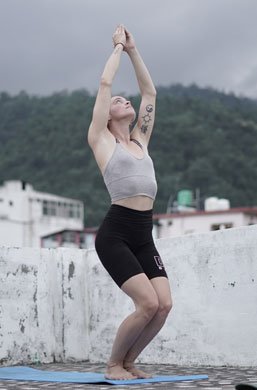Utkatasana is derived from Sanskrit word “Utkata” means “Chair” and “asana” means “Pose”.
Utkatasana may appear to be as simple as a yogi sitting in an imaginary chair. “When you execute the pose, it is definitely not a comfy, passive ride,” explains Prana Vinyasa Yoga creator Shiva Rea. “Utkatasana, or deep squat, rapidly activates the strength of your legs, back, and ankles.” Here, power is not so much about dominating or controlling others as it is about harmonising with the life energy within and around you. Utkatasana encourages you to find your seat of power within your pelvis, in the centre of your body.”
Utkatasana is a terrific pose to start your standing poses with. The energy of your feet firmly planted on the soil will provide anchoring, and as you extend into your spine, you’ll feel the subtle, cosmic energy carry you up. When practised regularly, utkatasana will develop the muscles in your legs, buttocks, back, and arms, making pose much simpler to hold. You’ll also improve hip strength and flexibility.
Read More: Why Is Kundalini Yoga Dangerous? The Truth About Its Risks and Rewards
How To Practice Utkatasana (Chair Pose)
- Stand in Samsthiti and place your feet inner-hip width distance apart or together with all toes facing forward.
- As you breath in raise your arms overhead, palms facing each other or palms together.
- Bend your knees and reach your seat back, so most of your weight is in your heels. Keep your knees over your feet. Make sure your thighs get parallel with ground if possible.
- Allow your upper body to lean forward slightly. If you were to look in a mirror, the line of your torso and the line of your thighs would approximately create a right angle.
- Draw your shoulder blades gently toward each other and down, keeping shoulders away from your ears.
- Lengthen through your spine to engage your lower back to stay long.
- Hold this posture according your comfortable capacity, then as you breathe in straiten your knees and as you breathe out release your arms.
- Stand in the Tadasana positions for few deep breaths and get relax.

Contraindications Of Utkatasana (chair Pose)
Avoid practising this yoga posture if you have any of the following conditions:
- Injury and Surgery:- This pose will be difficult to practise if you have chronic knee pain or a knee injury. As a result, it’s best done when the knees are completely healed or strong enough.
- Lack of Body-Breath Connections :- Students who do not have strong body-breath connections may have to hold their breath to stay in the pose. This is bad for the respiratory pattern, and such students may jolt their knees while aligning or releasing the pose.
- Physical Strength and Weak Body:- Students suffering from high blood pressure, dizziness, or migraines should avoid this stance. The neck bend with arms lifted might create dizziness and unbalance.
- Therapy and Restorative :- Despite the fact that this is a knee and body strengthening pose, yoga teachers must assess students’ physical fitness and rule out major spinal ailments, knee surgeries, or acute back pain before allowing them to practice.
- Others:- This pose should be avoided by pregnant women in their third trimester since carrying the weight of the womb is taxing on the hips and legs. Similarly, because senior citizens lack core and knee strength, this pose is not recommended for them. Postnatal women who are still regaining hip and pelvic joint strength should avoid this pose.
Read More: Everything You Need to Know About Kundalini Yoga Teacher Training

What are the benefits of Utkatasana
- It strengthens your ankles, calves, thighs, spine, and hip flexors.
- Stretches the muscles in your chest and shoulders.
- It stimulates the abdominal organs and the diaphragm.
- Prevents future knee injuries
- Flat feet relief
- Promotes heart health
- It Grounds Mind and Body
Deepen Your Yoga Practice with Hari Om Yoga Vidya School
Located in the heart of Rishikesh, Hari Om Yoga Vidya School is a place where ancient yogic wisdom meets modern teaching techniques. As a top yoga school in Rishikesh, we are committed to providing authentic, immersive yoga education in a peaceful, spiritual setting. Recognized as one of the best yoga schools in Rishikesh, we offer structured training programs designed to help you evolve in your practice, whether you are a beginner or an experienced yogi.
If you’re searching for a yoga school in Rishikesh that focuses on holistic learning, experienced teachers, and a supportive community, look no further!
Explore Our Yoga Teacher Training & Retreats
At Hari Om Yoga Vidya School, we offer a range of courses tailored for different levels of practitioners:
✅ 100-Hour Yoga Teacher Training in Rishikesh – A foundational course for those looking to begin their yoga journey.
✅ 200-Hour Yoga Teacher Training in Rishikesh – An internationally recognized certification for aspiring yoga teachers.
✅ 300-Hour Yoga Teacher Training in Rishikesh – Advanced training to deepen your practice and refine your teaching skills.
✅ 7-Day Yoga Retreat in Rishikesh – A rejuvenating escape into yoga, meditation, and self-discovery.
✅ 10-Day Yoga Retreats in Rishikesh – A transformative experience that blends yoga, relaxation, and Himalayan serenity.
Join us for a life-changing experience and become part of our global yoga family! 🌿✨



